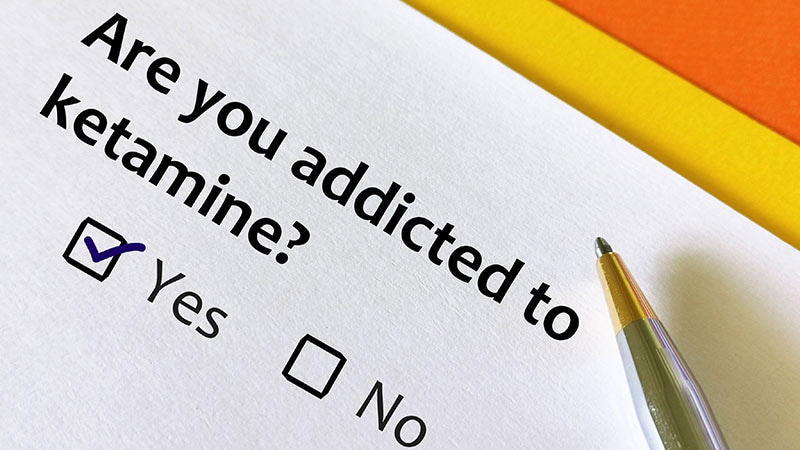Navigating the Complexities of GLP-1–Induced Skin Changes Navigating the Complexities of GLP-1–Induced Skin Changes
May 2, 2025Expert Panel Advises on Best Insulin Injection Techniques Expert Panel Advises on Best Insulin Injection Techniques
May 2, 2025
The majority of people with ketamine use disorder (KUD) don’t seek addiction treatment, despite reporting physical symptoms that include bladder and nasal problems and painful organ cramping, a large survey of people with KUD showed.
What’s more, when those with KUD do seek care, a significant number of clinicians lack understanding of the condition or offer only minimally effective treatment. The study also revealed previously unidentified symptoms associated with ketamine withdrawal.
“Our research is the first to analyze in-depth the experience of people using very large amounts of ketamine and shows the devastating physical health problems people can face with dependent ketamine use,” Celia Morgan, PhD, professor at the University of Exeter, Exeter, England, said in a statement. “Our study also highlights the barriers that people with ketamine addiction face when they try to seek treatment, often being sent away from treatment services.”
The study was published online on April 28 in the journal Addiction.
Underreported Symptoms
Data from the United States show a more than 1000% increase in the weight of seized ketamine between 2017 and 2022, while ketamine use has seen a more than twofold increase in the United Kingdom since 2016.
While ketamine — when used in controlled environments together with therapy — has clinical value in anesthesia and pain management, it also has the potential for abuse, particularly when prescribed in telehealth settings for at-home use, researchers said.
Investigators conducted an online survey of 274 individuals who self-identified as having KUD, with 68.7% reporting they were current ketamine users. The group included cisgender men (47.7%), cisgender women (44.2%), trans men (4.3%), and individuals who did not specify their gender (3.9%) who were of an average age of 28 years old and mainly resided in the United Kingdom (75%).
A majority of individuals (59.82%) said they were not seeking treatment. There were no significant demographic differences between the treatment and nontreatment groups.
Most respondents said they snorted ketamine (93%) as their route of administration and consumed an average of 2.0 g/d. Consumption was higher in treatment-seeking individuals (2.67 vs 1.68 g).
Symptoms of ketamine use reported in the survey included bladder problems (60%), nasal issues (60%), abdominal pain known as “K-cramps” (56%), and headaches (17%), as well as other symptoms (12%) relating to the kidney, gallbladder, pancreas, brain fog, heart palpitations, body aches, blood in urine, and erectile dysfunction.
A majority of respondents with symptoms did not seek treatment (56%), but when they did, they went to an emergency room (26%), or to see their doctor (25%) or a urologist (12%).
When respondents stopped taking ketamine, the majority reported cravings (71%), low mood (62%), anxiety, (59%) and irritability (45%) as common withdrawal symptoms.
Less common withdrawal symptoms included sleep disturbances, fatigue, abdominal pain, insomnia, lack of appetite, sweating, shaking, palpitations, dysphoria, tremors, and delusions.
Sleep disturbances, shaking, and delusions are newly identified symptoms of ketamine withdrawal, the researchers noted.
“The identification of these new symptoms may be attributed to the larger sample size used in this study, which has helped capture new insight into abstinence syndrome and highlight the inconclusive understanding of ketamine cessation in KUD,” they wrote.
When asked about their experiences with treatment centers, 31% said the centers where they sought care had little awareness of ketamine, 43% said the services they received did not address specific aspects of ketamine use, and 43% said they received broad treatments that were only somewhat effective.
Support groups were cited as the most effective treatment option (22%), followed by inpatient rehabilitation (20%), outpatient therapy (15%), and holistic therapies (4%). However, 13.5% of those who sought treatment for KUD reported that no treatment was effective.
“Our study highlights the need for greater recognition of the significant physical and psychological risks associated with ketamine, both among healthcare professionals and the general public. We need improved treatment programs, while raising awareness of ketamine use, to better support those seeking care,” Rebecca Harding, PhD candidate at University College London, London, England, said in a statement.
“By focusing on evidence-based treatments, such as specialized group therapy and pharmacological interventions, we can improve access to effective treatment and address the growing challenge of ketamine use disorder.”
This study was supported by the National Institute for Health and Care Research’s Efficacy and Mechanism Evaluation Program. The authors reported no relevant financial relationships.
